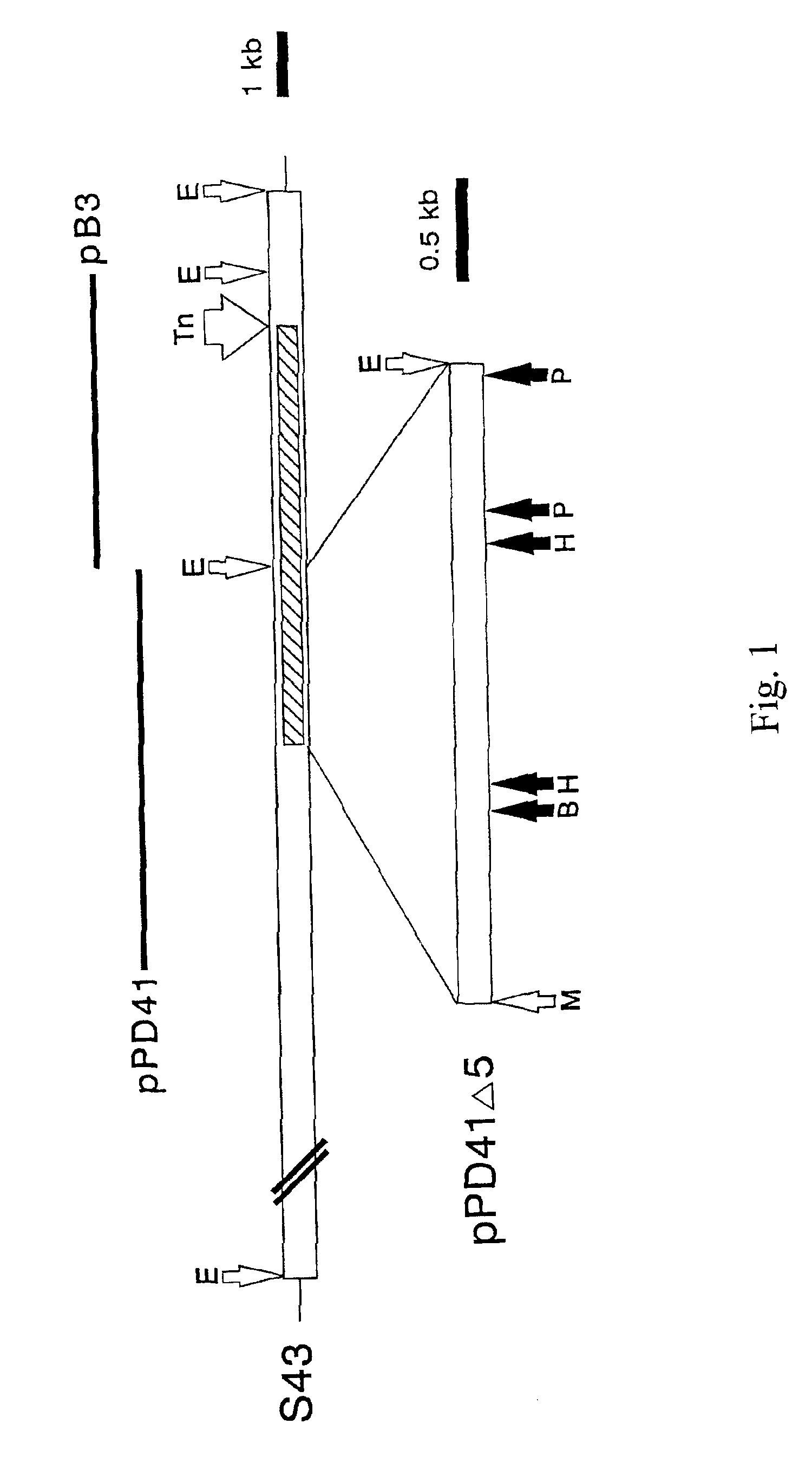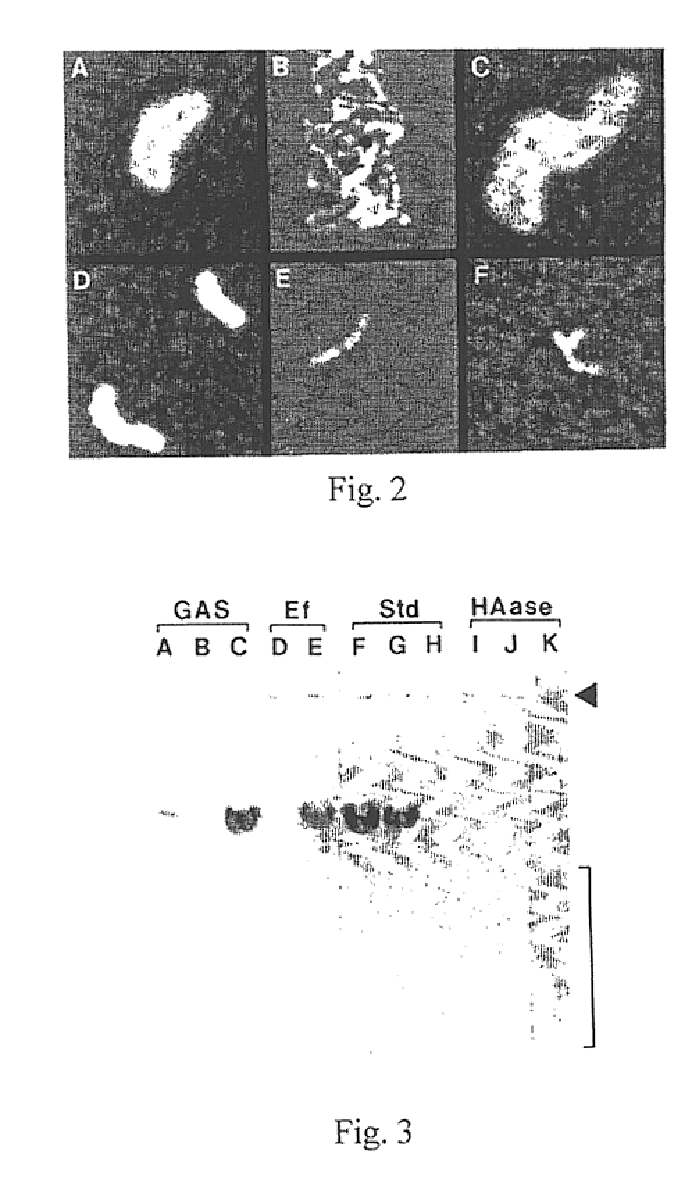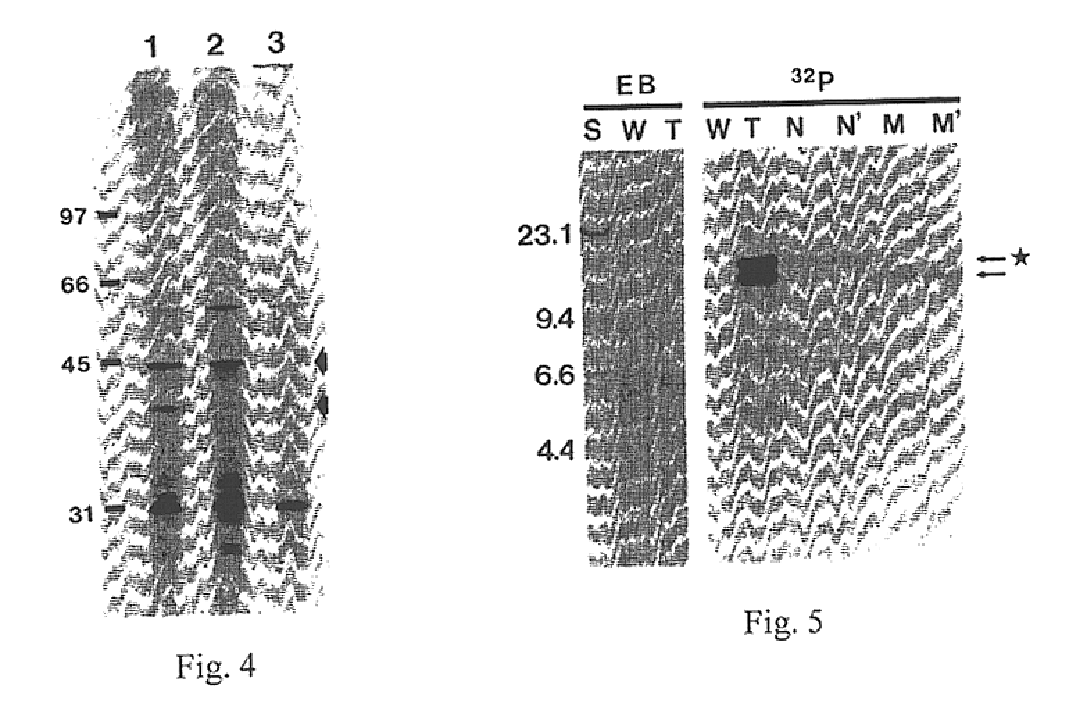Hyaluronate synthase gene and uses thereof
a technology of hyaluronate and synthese, which is applied in the direction of enzymology, organic chemistry, transferases, etc., can solve the problems of insufficient understanding of the mechanism of hyaluronate synthesis, and inability to fully realize the effect of synthesis
- Summary
- Abstract
- Description
- Claims
- Application Information
AI Technical Summary
Benefits of technology
Problems solved by technology
Method used
Image
Examples
example i
Isolation of the HA Synthase Locus
[0108]Tn insertional mutagenesis was used to tag and to mutate capsule biosynthesis genes of GAS. The bacteriophage A25 transducing lysate from one acapsular mutant, designated S43Tn7 and containing two Tn916 elements, was found to transmit the nonmucoid phenotype to 3 out of 5 transductants. The two Tn elements were segregated by transduction; one Tn insertion characterized by higher MW HindIII fragments was found only in the nonmucoid transductants (S43Td7N), while the other Tn insertion event producing lower MW fragments was found only in the mucoid cells (S43Td7M). Nonmucoid transductants did not possess HA synthase activity or a capsule as determined by enzyme assays of membranes or by light microscopy, respectively.
[0109]Materials and Methods
[0110]Materials: Media reagents were from Difco. Restriction and DNA modifying enzymes were from Promega unless otherwise noted. Synthetic oligonucleotides were made at the UTMB Synthesis Facility or by Ke...
example ii
Characterization of the HA Synthase Locus
[0121]When pPD41 was electroporated into the original acapsular Tn mutant, S43Tn7, or a spontaneously arising nonmucoid strain, S43Tn11, transformant colonies displayed the mucoid phenotype on agar plates, while cells with pB3 or pAT19 were nonmucoid. The capsules of the complemented cells were easily visualized by microscopy with India ink and were indistinguishable from the wild-type (FIG. 2). Ovine testicular hyaluronidase treatment of the cultures completely destroyed these capsules.
[0122]Using a sensitive radiometric assay, HA was detected in the cultures of the Tn-mutants containing pPD41 in amounts comparable to the wild-type parent (as shown in Table II). Transformants with pB3 or pAT19, as well as the original mutant without plasmid, did not produce HA (Table II). The HA was detected by proteoglycan binding; this high affinity interaction is very specific and is widely accepted as evidence for the presence of HA (Tengblad, 1980). As ...
example iii
Cloning of the HA Synthase Gene
[0136]The HA synthase gene of GAS was initially identified by Tn insertional mutagenesis as described in Example I. The bacteriophage A25 transducing lysate (Caparon and Scott, 1991) from one acapsular mutant (designated S43Tn7), which contained two Tn elements, transmitted the nonmucoid phenotype to 3 out of 5 transductants (FIG. 5). The nonmucoid transductants did not possess HA synthase activity or a capsule by light microscopy, but the mucoid transductants were equivalent to wild-type S43. HindIII digests of mutant S43Tn7 chromosomal DNA showed two bands migrating at 16 and 18 kb on agarose gels that corresponded to the higher MW bands detected by a Tn-specific probe on Southern blots of all TN916 mutants (FIG. 5). These larger species are the result of adding 10 kb of Tn DNA to the S43 HindIII fragment at the insertion site.
[0137]Since the Tn-tagged DNA from S43Tn7 was well resolved from the other HindIII fragments, it could be gel-purified. The 1...
PUM
| Property | Measurement | Unit |
|---|---|---|
| Acidity | aaaaa | aaaaa |
| Chemiluminescence | aaaaa | aaaaa |
Abstract
Description
Claims
Application Information
 Login to View More
Login to View More - R&D
- Intellectual Property
- Life Sciences
- Materials
- Tech Scout
- Unparalleled Data Quality
- Higher Quality Content
- 60% Fewer Hallucinations
Browse by: Latest US Patents, China's latest patents, Technical Efficacy Thesaurus, Application Domain, Technology Topic, Popular Technical Reports.
© 2025 PatSnap. All rights reserved.Legal|Privacy policy|Modern Slavery Act Transparency Statement|Sitemap|About US| Contact US: help@patsnap.com



